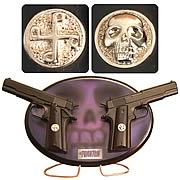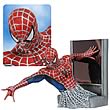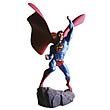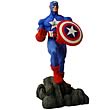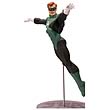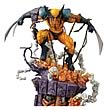Saturday, 21 April 2007
No 1096 - The Triads (Part one) plus Phantom World!
Posted by
Smartie
at
5:22 pm
0
comments
![]()
Labels: 1096, comic, frew, ghost who walks, phantom
No 1095 - The Curse of the Sacred Image
Posted by
Smartie
at
5:20 pm
0
comments
![]()
Labels: 1095, comic, frew, ghost who walks, phantom
The comic book guy
From SMH.com.au
Owen Thomson
March 17, 2007
This 73-year-old publisher can hardly wait to get to work every morning - it keeps him young.
Comic book hero The Phantom may enjoy worldwide kudos as "the man who cannot die" but his Australian publisher Jim Shepherd could perhaps be equally well celebrated as "the boy who never grew up".
Take the 73-year-old's inner-city office, for instance. Filled with classic Phantom memorabilia including mint-condition action figures and back issues, it's an inner sanctum that, if not for the formal-looking desk and computer, could almost be mistaken for a shrine to the purple-clad enigma.
"I can hardly wait to get to the office every morning," Shepherd says. "Right at this very minute I'm looking at a pile of artwork that dates back to 1939, just making sure that every single page is there. It keeps you young, it really does."
Becoming a successful comic book publisher was never one of Shepherd's job ambitions. That's not to say that comics didn't play an intrinsic role in his early life. Indeed, he thinks he probably taught himself to read by immersing himself in the medium.
"I can vividly remember reading Buck Rogers and Dick Tracy comic books and newspaper strips from the age of four or five," he says. "It was the artwork I loved the most. I really didn't take that much notice of the storylines or the cleverness of the dialogue. I became terribly interested in art and I still am."
But it was writing that ultimately dominated his early focus. "From the age of about 12 I always had this hankering to be a writer, but mainly a sports writer," he recalls. "When I was 13 or 14 I submitted some articles to a magazine called Australian Motor Sports and all my stuff was accepted. From that point on I think it was ego that was driving me a bit. It was this idea of 'How far can I go?"'
Since those formative years, Shepherd's career has been characterised by lashings of colourful diversity.
He started as a copy boy with the now defunct Associated Newspapers in 1950 and was subsequently awarded a journalism cadetship on The Daily Sun and Sunday Sun. Within a year he was offered a graded position at the rival Daily Telegraph and Sunday Telegraph.
"I became a D-grade sports writer after one year's cadetship and never ever passed the shorthand exam," he recalls with mild satisfaction.
Shepherd's next step was into radio as a broadcaster and promotions manager at 2CH before moving to 2UE as that station's No. 2 sports broadcaster. He then opted temporarily out of journalism to become national advertising manager for food canning company Gordon Edgell and Sons.
"I had the company car and a lot more money, but that frankly became a little bit boring and I think I was hankering for the old days of seeing my name in print or hearing myself on radio. Then out of the blue Channel Ten started in the early 1960s. I had an offer to join as the sporting director so I did."
After six years he took the role of national promotions manager for tobacco company Rothmans, remaining in the position for nearly a decade before leaving to start his own small publishing company.
But it was in late 1987 that the most significant event of his professional life occurred in the form of a chance lunchtime encounter with the then owners of Frew Publications, the company that has published The Phantom continuously in Australia since 1948. As Shepherd recalls, their situation looked grim.
"They said to me: 'You could be just the guy we need. It looks as though we're going to lose the licence to publish The Phantom because we're both so old and [Phantom owners] King Features Syndicate are not very happy with the product. Would you like a trip over to New York to see if you can save our bacon?'
"I thought, 'Why not?"'
Shepherd flew to the US and impressed the King Features hierarchy with an impromptu plan to revive the title's flagging fortunes "but by the time I got back to Australia one of the partners had died and the other had had a stroke".
Never one to pass up an unexpected opportunity, Shepherd took over the company with a silent partner. After five years he decided to buy out all shareholders and become the sole owner.
Today The Phantom's circulation figures hover at a healthy 25,000 an issue. But anyone who thinks Shepherd's role is nothing more than child's play should think again. Frew publishes 31 editions a year, a schedule that uses up nearly 60 stories.
"About 20 to 26 of those stories also have to be translated from Swedish into English and then lettered," he explains.
"All the covers have to be designed and commissioned. I do all the editorial pieces, design a lot of the covers, physically do the artwork myself on occasions and select the stories. On four occasions, I've actually written the stories as well."
Track record
Qualifications what used to be called the leaving certificate. That's it. I've no other academic qualifications whatsoever.
Work motto I think the only way to success with writing is to keep working on it, keep polishing, keep honing. Never think you've got it made. Keep looking at your work and being terribly critical of yourself.
Lucky break bumping into the two guys who were then running Frew Publications. It opened the doors to international travel and meeting a lot of people I'd only ever heard about. I can now say I've had coffee with Catherine Zeta-Jones, Billy Zane and (Phantom creator) Lee Falk and so many famous artists and writers.
Posted by
Smartie
at
4:56 pm
0
comments
![]()
Labels: comic, frew, jim shepherd, lee falk, phantom
The Phantom fresh as ever for his 1500th adventure
From - The SMH.com.au
Julian Lewis
April 14, 2007
AUSTRALIA'S most popular comic, The Phantom, has made publishing history with the printing of the 1500th consecutive issue of the adventures of the legendary jungle ruler.
The Ghost Who Walks, introduced to Australians in 1936 in the now defunct Australian Women's Mirror, predated Batman and Superman and was the brainchild of a young Missouri-born writer, Lee Falk, who had already conceived his other great comic kingdom character, Mandrake the Magician.
Brilliantly simple in concept, the Phantom did not have superpowers but was a multi-skilled, physically impressive and well-educated crime fighter who lived in the mysterious "Deep Woods". From there, he came and went pursuing the fight for justice. His adventures ran in the Mirror without pause until it folded in 1961.
Although the Mirror issued five Phantom comic books in 1938, it was not until the postwar years that The Phantom began its assault on the world record for consecutive publishing when a Sydney company, Frew, began issuing the comics in 1948.
Frew was so unsure of the publication's potential - or market - that the first issue was given a cover price of sixpence, and was not numbered.
Frew changed Falk's original title, The Slave Traders, to Enter the Phantom. Original copies in mint condition are rare and are valued at thousands of dollars. The publisher owns only two complete Phantom collections in mint condition, and these are said to be worth well over $100,000 each.
The Phantom gained a cult following, ironically bigger in Australia and other unexpected places such as the South Pacific and Scandinavia, where there is a Phantom theme park, than in Falk's homeland, where it never reached the heights of comic superstardom.
During the past 60 years The Phantom has been published continuously in Australia. It appeared every three weeks from 1956, then fortnightly from 1959. Various special issues and numbering hiccups account for the total 1500 issues. These are now being commemorated by Frew with a special issue containing Falk's first daily and Sunday newspaper stories, one from 1936 and one from 1939.
A Phantom "encyclopedia" has also been compiled, produced jointly by Frew and a sometime Phantom story creator, the Sydney writer Jim Shepherd, who even had the Phantom journey Down Under in one adventure, meeting the then prime minister and real-life Phantom fan Bob Hawke.
Arguments about the many variations of Falk's famous character may be settled by Frew's Phantom historian, Barry Stubbersfield, who has chronicled the many writers who contributed story lines that were officially sanctioned but did not form part of Falk's official history of the 343 continuous daily and Sunday Phantom adventures on which he worked until his death in 1999, at the age of 87.
Reprints of carefully reconstructed Falk originals have been a regular highlight of Frew's publishing schedule. With the help of stories from overseas writers - and Shepherd himself on occasion - and despite the lack of new material from Falk, The Phantom still sells close to a million copies a year in Australia. Total Frew sales since 1948 are estimated at 35 million copies.
The comic that cannot die still seems to rule the genre's publishing jungle from a Skull Cave in Sydney's central business district. The No.1500 Frew special edition of The Phantom is on sale at $11.
Posted by
Smartie
at
3:07 pm
0
comments
![]()
Labels: annual special, frew, ghost who walks, lee falk, phantom
No 1094 - Lee Falk Tribute Issue!


Complete with School Project Kit, replica of the 4th Phantom comic published by Frew, and thirteen stories published:
- The Mysterious Passenger
- A Proper Husband
- The Wisdom of Solomon
- The Valley of No Return
- The Veiled Lady
- Rex King
- The Rogue Elephant
- Strangers at Keela-Wee
- Rex & The Trophy Hunters
- The Sky Divers
- Rex & The Little People
- The Pampered Princess
- The Return of General Bababu
All stories are by Lee Falk, and inked either by Sy Barry or Wilson McCoy
Posted by
Smartie
at
2:02 pm
0
comments
![]()
Labels: 1061 sy barry, 1094, annual special, comic, frew, ghost who walks, lee falk, phantom, wilson mccoy
No 1093 - Hijackers on Board!
Posted by
Smartie
at
2:01 pm
0
comments
![]()
Labels: 1093, comic, frew, ghost who walks, phantom
No 1092 - The King of Chicago
Posted by
Smartie
at
2:00 pm
0
comments
![]()
Labels: 1092, comic, frew, ghost who walks, phantom
No 1091 - The Commander Is Dead!
Posted by
Smartie
at
1:59 pm
0
comments
![]()
Labels: 1091, comic, frew, ghost who walks, jungle patrol, phantom
No 1090 - The Vandal Looters
Posted by
Smartie
at
1:58 pm
0
comments
![]()
Labels: 1090, comic, frew, ghost who walks, phantom
No 1089 - Seconds from Death
Posted by
Smartie
at
1:56 pm
0
comments
![]()
Labels: 1089, comic, frew, ghost who walks, phantom
Friday, 20 April 2007
No 1088 - The Climax of The Evil Game!
Posted by
Smartie
at
7:29 pm
0
comments
![]()
Labels: 1088, comic, frew, ghost who walks, lee falk, phantom
No 1087 - The Evil Game! (Part One)
Posted by
Smartie
at
7:28 pm
0
comments
![]()
Labels: 1087, comic, frew, ghost who walks, phantom
No 1086 - Struggle For Freedom
Posted by
Smartie
at
7:27 pm
0
comments
![]()
Labels: 1086, comic, frew, ghost who walks, lee falk, phantom
No 1085 - Princess Valerie
Posted by
Smartie
at
7:26 pm
0
comments
![]()
Labels: 1085, comic, frew, ghost who walks, lee falk, phantom
No 1084 - Hunted! (The Fugitive)
Posted by
Smartie
at
7:25 pm
0
comments
![]()
Labels: 1084, comic, frew, ghost who walks, lee falk, phantom
No 1083 - The Demon of Wasaka
Posted by
Smartie
at
7:24 pm
0
comments
![]()
Labels: 1083, comic, ghost who walks, lee falk, phantom
No 1082 - The Revenge Of Dogai Singh!
Posted by
Smartie
at
7:23 pm
0
comments
![]()
Labels: 1082, comic, frew, ghost who walks, lee falk, phantom
No 1081 - The Plotters PLUS The Isle of Death
Posted by
Smartie
at
7:16 pm
0
comments
![]()
Labels: 1081, comic, frew, ghost who walks, lee falk, phantom
Monday, 16 April 2007
No 1080 - The Loser! Election in Begali part two
Posted by
Smartie
at
10:01 pm
0
comments
![]()
Labels: 1080, comic, frew, ghost who walks, lee falk, phantom
No 1079 - Election in Bengali!
Posted by
Smartie
at
10:00 pm
0
comments
![]()
Labels: 1079, comic, frew, ghost who walks, lee falk, phantom
No 1078 - Three Falk-McCoy Classics!
Posted by
Smartie
at
9:58 pm
0
comments
![]()
Labels: comic, frew, ghost who walks, lee falk, phantom, wilson mccoy
No 1077 - The Doomsday Mountain!
Posted by
Smartie
at
9:28 pm
1 comments
![]()
Labels: 1077, comic, frew, ghost who walks, lee falk, phantom
No 1076 - Operation Jungle Patrol!
Posted by
Smartie
at
9:27 pm
0
comments
![]()
Labels: 1076, comic, frew, ghost who walks, phantom
No 1074 - The Ghost of Tawasu Valley
Posted by
Smartie
at
9:23 pm
0
comments
![]()
Labels: 1074, comic, frew, ghost who walks, lee falk, phantom
Sunday, 15 April 2007
No 1075 - Carlyle's Good Mark
Posted by
Smartie
at
10:20 pm
0
comments
![]()
Labels: 1075, comic, frew, ghost who walks, phantom
No 1073 - Dinosaur!
Posted by
Smartie
at
10:19 pm
0
comments
![]()
Labels: 1061 sy barry, 1073, comic, frew, ghost who walks, phantom
















































